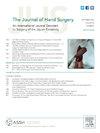臂丛先天性损伤的临床分型与MRI表现。
IF 2.1
2区 医学
Q2 ORTHOPEDICS
引用次数: 0
摘要
目的:Narakas分类法根据临床检查的运动无力模式,根据神经根损伤来描述臂丛出生损伤(BPBI)。然而,目前尚不清楚这种分类是否真的与所描述的神经根相对应。将脑卒中婴儿神经根损伤的MRI表现与临床分型进行比较。方法:前瞻性纳入三家儿童医院的BPBI患儿,通过体格检查确定Narakas组。婴儿在16周龄前接受MRI检查。神经放射科医生在MRI上确定每个神经根的损伤严重程度(完整、破裂、撕脱)。根据临床Narakas分类,将MRI显示的神经根损伤与预期的神经根损伤进行比较。结果:68名婴儿完成MRI检查,显示19种不同的神经损伤模式。神经根损伤的MRI结果并不总是与Narakas分类所期望的神经根受累相符。在Narakas 1患者中,23%仅C5-C6损伤,55% C7、C8和/或T1有额外损伤。在Narakas的2例患者中,只有26%的患者仅发生C5-C7损伤。在Narakas 3和4组中,根据Narakas分类,43%的患者有C5-T1全局性损伤。受影响神经根的平均数量和平均撕脱随Narakas分级的增加而增加。最常见的神经根损伤和撕脱分别是C6 (n = 60)和C8 (n = 15)。结论:在68名婴儿中,鉴定出19种不同的损伤模式,表明BPBI的病理解剖比传统描述更为微妙。对于Narakas 1号和2号婴儿,MRI显示的神经根损伤往往比临床检查预期的更广泛。我们的结果表明,Narakas分类可能与MRI上看到的根水平损伤不精确对应。研究类型/证据水平:诊断性II。本文章由计算机程序翻译,如有差异,请以英文原文为准。
Clinical Classification Versus MRI Patterns of Injury in Brachial Plexus Birth Injury
Purpose
The Narakas classification describes brachial plexus birth injury (BPBI) according to nerve root injury by the pattern of motor weakness on clinical examination. However, it is unknown whether the classification truly corresponds to the described nerve roots. The distribution of nerve root injuries on magnetic resonance imaging (MRI) in infants with BPBI was compared with the clinical classification.
Methods
Infants with BPBI were prospectively enrolled at three children’s hospitals, and the Narakas group was determined by physical examination. Infants underwent MRI prior to age 16 weeks. Neuroradiologists determined the injury severity (intact, rupture, avulsion) at each nerve root on MRI. The nerve root findings on MRI were compared with the expected nerve root injuries, based on the clinical Narakas classification.
Results
Sixty-eight infants completed the MRI revealing 19 distinct patterns of nerve injury. The nerve root injury findings on MRI did not always correspond with the nerve roots involvement expected based on the Narakas classification. In Narakas 1 patients, 23% had injury to C5–C6 only, and 55% had additional injuries to C7, C8, and/or T1. In Narakas 2 patients, only 26% had an injury specifically to C5–C7 only. In the Narakas 3 and 4 groups, 43% had a C5–T1 global injury as expected by the Narakas classification. The mean number of nerve roots affected, and mean avulsions increased with higher Narakas grades. The most commonly injured and avulsed nerve roots were C6 (n = 60) and C8 (n = 15), respectively.
Conclusions
In 68 infants, 19 different patterns of injury were identified, suggesting that the pathoanatomy of BPBI is more nuanced than classically described. For Narakas 1 and 2 infants, the nerve root injury on MRI was often more extensive than expected based on clinical examination. Our results suggest the Narakas classification may not precisely correspond with the injury at the root level, as seen on MRI.
Type of study/level of evidence
Diagnostic II.
求助全文
通过发布文献求助,成功后即可免费获取论文全文。
去求助
来源期刊
CiteScore
3.20
自引率
10.50%
发文量
402
审稿时长
12 weeks
期刊介绍:
The Journal of Hand Surgery publishes original, peer-reviewed articles related to the pathophysiology, diagnosis, and treatment of diseases and conditions of the upper extremity; these include both clinical and basic science studies, along with case reports. Special features include Review Articles (including Current Concepts and The Hand Surgery Landscape), Reviews of Books and Media, and Letters to the Editor.

 求助内容:
求助内容: 应助结果提醒方式:
应助结果提醒方式:


